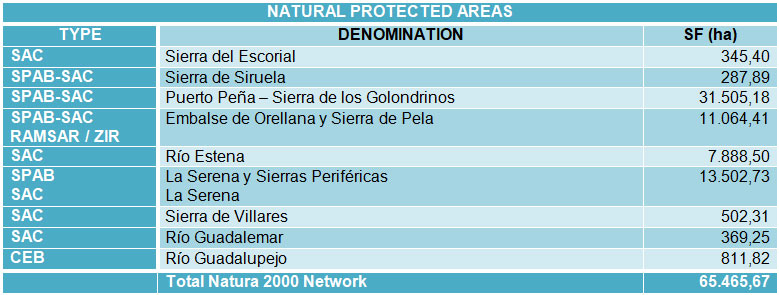NATURAL HERITAGE
The landscapes and ecosystems that La Siberia presents have a high degree of conservation and variety, with the region having one of the highest Biodiversity indexes in the Iberian Peninsula. The isolated and sparsely populated nature of this region has contributed to this, but also the commitment to traditional farming practices.
In its wide variety of ecological environments we find diverse flora and fauna, forests that include multiple tree species and all kinds of bushes. Pastures and meadows, plains, wetlands and mountains form different habitats that are complemented by the large aquatic areas that bathe the region, with an impressive river wealth, not in vain is considered the largest inland coast of Spain, thanks to its kilometric extensions of coasts of fresh water. Its vegetal richness is such, that it counts on 26 Habitats of Community Interest, 4 of which are considered of Priority Interest.
La Siberia is rich in Biodiversity, not only in its flora, but also in its fauna. There are nearly 500 species of vertebrates, from multiple fish such as pike, carp, barbel or black - bass, in their numerous fishing areas, to which the reservoirs of the area contribute to a large extent; to mammals associated with the Mediterranean forest, crops and meadows such as deer, roe deer, wild boar and otters. It should be noted in this regard the settlement of chiropter communities in some areas, amphibians and reptiles. But if there is a category of animals that by their presence stand out above the rest in La Siberia, that is the birdlife. Hundreds of birds can be seen in the landscapes of La Siberia, which is an ornithological paradise, ideal for lovers of "Birdwatching" or ornithological tourism, which can contemplate the birds from the many natural viewpoints that can be found in the region.
All these elements make La Siberia an impressive natural space, which has led to the declaration of several Protected Natural Spaces, sheltered by various figures. Internationally protected places converge in the territory as SPAB (Zones of Special Protection Areas for Birds) and SAC (Special Areas of Conservation) within the Natura 2000 Network, as can be seen in the table presented here.


